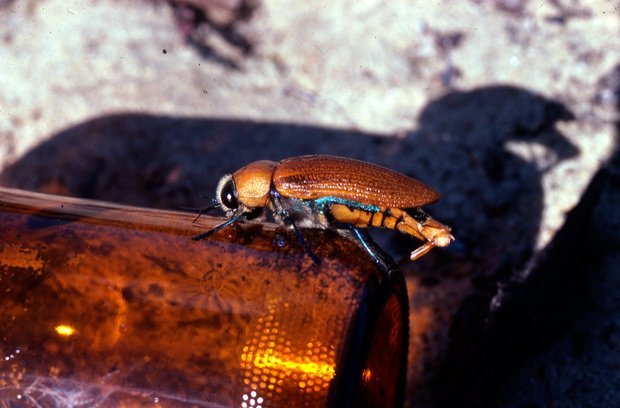Nature mimics: why bugs mate with beer bottles

JEWEL BEETLES HAVE BEEN known for inspiring engineering innovations of such things as forest fire sensors, new materials, and even palace decor. But one Australian jewel beetle (Julodimorpha bakewelli) has achieved fame simply by choosing a rather unorthodox mate: a beer stubbie.
When professors Darryl Gwynne and David Rentz first noticed the male beetles’ strange behaviour back in the early 1980s, they realised the creatures were simply seeking out the most attractive mate.
When the Western Australian beer industry unintentionally produced bottles that mimicked the shiny brown sheen of the female jewel beetle, the males found themselves in what researchers refer to as an `evolutionary trap’ – they were responding to cues that once offered an evolutionary advantage, but ended up leading them astray as a result of environmental change.
“As a consequence of their mating mistakes, the males [jewel beetles] experience reduced survival,” says Darryl, a biologist at University of Toronto at Mississauga. “Attempts to copulate with stubby beer bottles continue until they are killed by the hot desert sun or by foraging ants.”
Darryl and David recently received an Ig Nobel prize for their curious observation, bringing the subject of their study into the limelight once again. But these jewel beetles are not the only creatures that suffer at the hands of evolution; as it turns out, several other species in Australia have found themselves in similarly misleading situations.
Irresistible lure of an evolutionary trap
The Australian crab spider (Thomisus spectabilis), does not build webs, but instead lies in wait for its lunch from the safety of a flower. Scientists once thought the spider’s appearance helped camouflage the creature from its prey, but an Australian study found the opposite to be true: this species actually advertises its presence by reflecting ultraviolet (UV) light.
For the recently introduced European honeybee, this UV light acts as an irresistible lure that attracts the bees towards the spiders.
“All insects have a receptor in their eye that’s specific to UV, and this receptor is very, very sensitive,” says Professor Marie Herberstein, a biologist at Macquarie University who co-authored the study. “Insects have an innate response to UV light. We think it’s because if you think of an insect in a shrub, in an under story, and they need a quick escape, the best way is to go towards an open light – the sky.”
While the attraction is still present for Australian pollinators, it is not nearly as strong. Unlike European honeybees, Australian pollinators find the occupied flowers interesting, but are less likely to land near a crab spider than their European counterparts.
“What humans have done is moved these European bees to Australia, so they’re trapped in this new environment,” Marie says. “All of a sudden there’s this new predator.”
But human action is not the only cause of evolutionary traps. Some native species have found ways to take advantage of their prey’s inborn survival instincts.
Mistaken identity
Australian wasps have long been known to fall prey to a native orchid’s seductive ways.
“Orchids are really famous for their wide variety of evolutionary traps,” says Dr Anne Gaskett, a biologist at The University of Auckland, in New Zealand. “They have a diverse range of ways of fooling insects into acting as pollinators without having to give them a reward.”
Australian tongue orchids (Cryptostylis), for example, have evolved to mimic the scents and appearance of female wasps (Lissopimpla excelsa), in order to trick male wasps into spreading their pollen.
Anne was the first to find evidence that these male wasps will even go so far as to waste precious sperm on the orchids.
“Most insects are actually quite limited,” Anne says. “They may only have a certain amount of sperm they have to spend wisely throughout their life.”
A wasp’s encounter with an orchid, in other words, may reduce its ability to reproduce. Because most wasps only encounter these orchids once in a long while, they have not developed the ability to resist the flowers’ compelling display – even when offered a clear alternative.
“If there are orchids around, the males tend to ignore the females,” Anne says. “[The orchids are] just so compelling. There are smells, colours, textures- and all of it says mate with this.”
Furry armour
Ants are known to be formidable adversaries. With their large mandibles and deep-seated attack instincts, only the foolish mess with these creatures. Unless, of course, you are a hungry feather-legged assassin bug (Ptilocnemus lemur). This innocent-looking species makes use of the ant’s natural attack instinct to help capture its favourite snack.
“This is again a deceptive signal,” says Marie, whose PhD student, Matthew Bulbert, studies the hairy-legged assassin bug.
The assassin bug waves its hairy hind legs, provoking the ant to attack. The ant, so intently focused on destroying the bug’s heavily armoured legs, fails to defend itself from the assassin bug’s sharp trunk. The bug stabs its victim on the back of the head, killing it quickly. The ant, in other words, has fallen into a natural evolutionary trap.
“You have these systems persisting because there are lots and lots of ants” and relatively few assassin bugs, Marie says.
Also, the reproductive cost of falling for the assassin bug’s ploy is relatively low: it is the typically sterile worker ant, not the fertile queen, which typically pays the ultimate price.
RELATED STORIES

